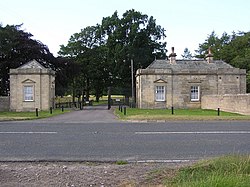
Glamis Castle is situated beside the village of Glamis in Angus, Scotland. It is the home of the Earl of Strathmore and Kinghorne, and is open to the public.

Earl of Strathmore and Kinghorne is a title in the Peerage of Scotland and the Peerage of the United Kingdom. The earl is also Chief of Clan Lyon.

Claude George Bowes-Lyon, 14th and 1st Earl of Strathmore and Kinghorne,, styled as Lord Glamis from 1865 to 1904, was a British peer and landowner who was the father of Queen Elizabeth The Queen Mother and the maternal grandfather of Queen Elizabeth II.
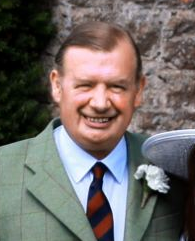
Michael Fergus Bowes-Lyon, 18th and 5th Earl of Strathmore and Kinghorne,, styled Lord Glamis between 1972 and 1987, also known as Mikey Strathmore, was a British Conservative politician, Scots Guards officer and stockbroker. He was a first cousin once removed of Queen Elizabeth II.

Gibside is an estate in Tyne and Wear, North East England. It is located in the valley of the River Derwent on the border with County Durham, between Rowlands Gill and Burnopfield. The estate is the surviving part of a Georgian landscaped park, primarily created under the ownership of Sir George Bowes (1701–1760) and designed in large part by Stephen Switzer and William Joyce.

The Bowes-Lyon family descends from George Bowes of Gibside and Streatlam Castle (1701–1760), a County Durham landowner and politician, through John Bowes, 9th Earl of Strathmore and Kinghorne, chief of the Clan Lyon. Following the marriage in 1767 of the 9th Earl to rich heiress Mary Eleanor Bowes, the family name was changed to Bowes by Act of Parliament. The 10th Earl changed the name to Lyon-Bowes and the 13th Earl, Claude, changed the order to Bowes-Lyon.
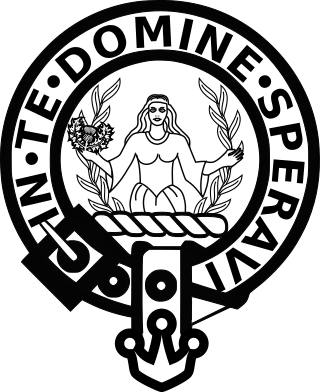
Clan Lyon is a Scottish clan.

Patrick Bowes-Lyon, 15th and 2nd Earl of Strathmore and Kinghorne,, styled as Master of Glamis until 1904 and Lord Glamis until 1944, was a British landowner, peer and British Army officer. He was the eldest brother of Queen Elizabeth The Queen Mother, thus a maternal uncle of Queen Elizabeth II.

Patrick Lyon, 3rd Earl of Strathmore and Kinghorne was a Scottish peer and nobleman. He was the son of John Lyon, 2nd Earl of Kinghorne and his wife Lady Elizabeth Maule, daughter of Patrick Maule, 1st Earl of Panmure and Frances Stanhope. Patrick was the grandson of Patrick Lyon, 1st Earl of Kinghorne and his wife Anne Murray.

Baron Bowes is a title that has been created three times, once in the Peerage of Ireland and twice in the Peerage of the United Kingdom. The first creation came in the Peerage of Ireland on 15 August 1758 when John Bowes, Lord Chancellor of Ireland, was made Baron Bowes, of Clonlyon. The title became extinct on his death in 1767. The second creation came in the Peerage of the United Kingdom on 7 August 1815 when John Bowes, 10th Earl of Strathmore and Kinghorne, was made Baron Bowes, of Streatlam Castle in the County of Durham and of Lunedale in the County of York. The barony became extinct on his death in 1820 while the earldom was passed on to his younger brother, the eleventh Earl. The barony was revived on 1 July 1887 when the latter's grandson, Claude Bowes-Lyon, 13th Earl of Strathmore and Kinghorne, was made Baron Bowes, of Streatlam Castle in the County of Durham and of Lunedale in the County of York. See Earl of Strathmore and Kinghorne for further history of the title.

Cecilia Nina Bowes-Lyon, Countess of Strathmore and Kinghorne was the mother of Queen Elizabeth The Queen Mother, and maternal grandmother and godmother of Queen Elizabeth II.

Sir George Bowes was an English coal proprietor and Whig politician who sat in the House of Commons for 33 years from 1727 to 1760.

John Bowes, 9th Earl of Strathmore and Kinghorne, born John Lyon, was a Scottish nobleman and peer. He was the 9th Earl of Strathmore and Kinghorne and one of the maternal ancestors of King Charles III.

John Bowes was an English art collector and thoroughbred racehorse owner who founded the Bowes Museum in Barnard Castle, Teesdale.

Claude Bowes-Lyon, 13th Earl of Strathmore and Kinghorne, styled The Honourable Claude Bowes-Lyon from 1847 to 1865, was a British peer. He was the 13th holder of the Earldom of Strathmore and Kinghorne, the paternal grandfather of Queen Elizabeth The Queen Mother, a great-grandfather of Elizabeth II, and great-great-grandfather of Charles III.
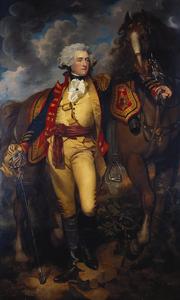
John Bowes, 10th Earl of Strathmore and Kinghorne was a Scottish nobleman and peer. He was the eldest son of John Bowes, 9th Earl of Strathmore and Kinghorne and Mary Bowes, Countess of Strathmore and Kinghorne. He lived mainly on his estates in Durham.

Thomas George Lyon-Bowes, 12th Earl of Strathmore and Kinghorne, styled Lord Glamis between 1834 and 1846, was a Scottish peer and cricketer.
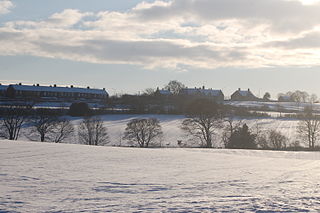
Marley Hill is a former colliery village about six miles to the south west of Gateshead, near the border between Tyne and Wear and County Durham. It has been part of the Metropolitan Borough of Gateshead since 1974. Prior to this it was part of Whickham Urban District. It lies within the Whickham South & Sunniside electoral ward of the Blaydon parliamentary constituency.
The Lyons family is an eminent Anglo-Norman family descended from Ingelram de Lyons, Lord of Lyons, who arrived in England with the Norman Conquest, and from his relation, Nicholas de Lyons, who emigrated from Normandy to England in 1080 and was granted lands at Warkworth, Northamptonshire by William of Normandy. The family originated in the district of the Forest of Lyons, north of the town of Lyons-la-Forêt, in Haute Normandie, where their seat was the Castle of Lyons. The original surname was 'de Lyons' : subsequently, the 'de' was removed from the name, and some branches removed the 's' from the end of the word, producing 'Lyon'.
Simon Patrick Bowes-Lyon, 19th and 6th Earl of Strathmore and Kinghorne, styled as Lord Glamis until 2016, is a Scottish peer and landowner, the owner of estates based at Glamis Castle.
